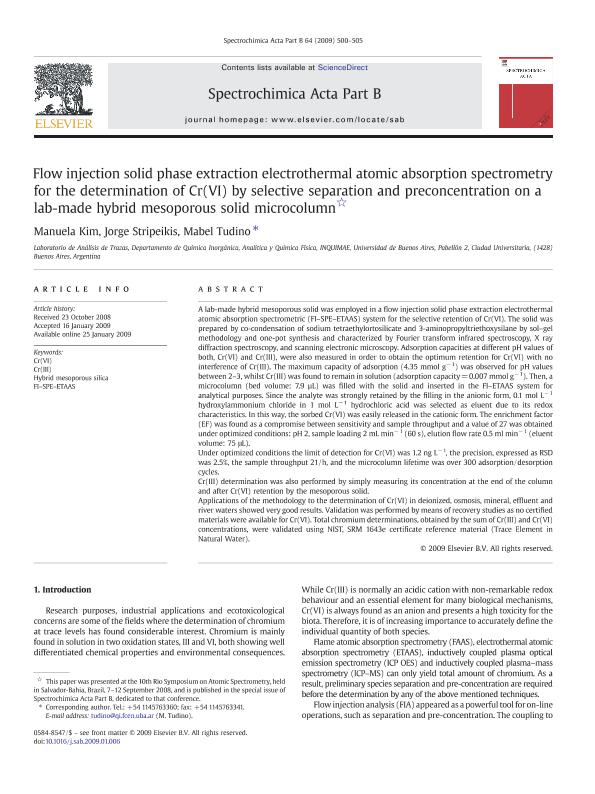Artículo
Flow injection solid phase extraction electrothermal atomic absorption spectrometry for the determination of Cr(VI) by selective separation and preconcentration on a lab-made hybrid mesoporous solid microcolumn
Fecha de publicación:
06/2009
Editorial:
Pergamon-Elsevier Science Ltd
Revista:
Spectrochimica Acta Part B: Atomic Spectroscopy
ISSN:
0584-8547
Idioma:
Inglés
Tipo de recurso:
Artículo publicado
Clasificación temática:
Resumen
A lab-made hybrid mesoporous solid was employed in a flow injection solid phase extraction electrothermal atomic absorption spectrometric (FI-SPE-ETAAS) system for the selective retention of Cr(VI). The solid was prepared by co-condensation of sodium tetraethylortosilicate and 3-aminopropyltriethoxysilane by sol-gel methodology and one-pot synthesis and characterized by Fourier transform infrared spectroscopy, X ray diffraction spectroscopy, and scanning electronic microscopy. Adsorption capacities at different pH values of both, Cr(VI) and Cr(III), were also measured in order to obtain the optimum retention for Cr(VI) with no interference of Cr(III). The maximum capacity of adsorption (4.35 mmol g- 1) was observed for pH values between 2-3, whilst Cr(III) was found to remain in solution (adsorption capacity = 0.007 mmol g- 1). Then, a microcolumn (bed volume: 7.9 μL) was filled with the solid and inserted in the FI-ETAAS system for analytical purposes. Since the analyte was strongly retained by the filling in the anionic form, 0.1 mol L- 1 hydroxylammonium chloride in 1 mol L- 1 hydrochloric acid was selected as eluent due to its redox characteristics. In this way, the sorbed Cr(VI) was easily released in the cationic form. The enrichment factor (EF) was found as a compromise between sensitivity and sample throughput and a value of 27 was obtained under optimized conditions: pH 2, sample loading 2 mL min- 1 (60 s), elution flow rate 0.5 ml min- 1 (eluent volume: 75 μL). Under optimized conditions the limit of detection for Cr(VI) was 1.2 ng L- 1, the precision, expressed as RSD was 2.5%, the sample throughput 21/h, and the microcolumn lifetime was over 300 adsorption/desorption cycles. Cr(III) determination was also performed by simply measuring its concentration at the end of the column and after Cr(VI) retention by the mesoporous solid. Applications of the methodology to the determination of Cr(VI) in deionized, osmosis, mineral, effluent and river waters showed very good results. Validation was performed by means of recovery studies as no certified materials were available for Cr(VI). Total chromium determinations, obtained by the sum of Cr(III) and Cr(VI) concentrations, were validated using NIST, SRM 1643e certificate reference material (Trace Element in Natural Water).
Palabras clave:
Cr(Iii)
,
Cr(Vi)
,
Fi-Spe-Etaas
,
Hybrid Mesoporous Silica
Archivos asociados
Licencia
Identificadores
Colecciones
Articulos(INQUIMAE)
Articulos de INST.D/QUIM FIS D/L MATERIALES MEDIOAMB Y ENERGIA
Articulos de INST.D/QUIM FIS D/L MATERIALES MEDIOAMB Y ENERGIA
Citación
Kim, Manuela Leticia; Stripeikis, Jorge Daniel; Tudino, Mabel Beatriz; Flow injection solid phase extraction electrothermal atomic absorption spectrometry for the determination of Cr(VI) by selective separation and preconcentration on a lab-made hybrid mesoporous solid microcolumn; Pergamon-Elsevier Science Ltd; Spectrochimica Acta Part B: Atomic Spectroscopy; 64; 6; 6-2009; 500-505
Compartir
Altmétricas




